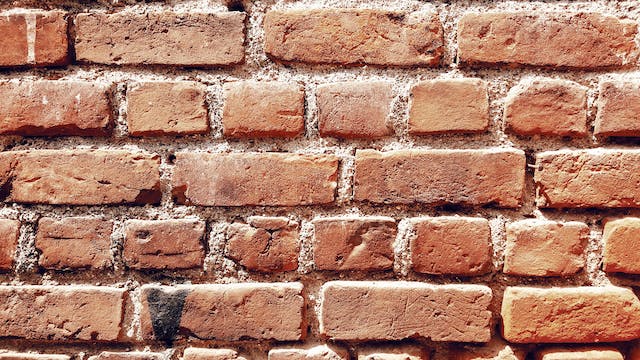
How does mortar keep the bricks together? It holds the bricks together in a similar way to how glue holds wood together. It also acts as a waterproof sealant.
Mortars are not always made of the same material. They are any material that holds together the bricks or stones used to make buildings. Mortars have existed since people started making houses with more than just rocks balanced together. Any wall built of just rock will have gaps that the wind can get through. These gaps can be filled with smaller stones and even sand, but a loose filling will not support the wall as well as mortar. The first mortars were made of mud and clay. They can be found in buildings from about 12,000 years ago in Jericho.
In Egypt, mortar had become a combination of mud, clay, and sand. The Greeks made mortar using lime and volcanic ash. This mortar was strong and waterproof. The Romans improved on it by adding sand and crushed terra cotta. It was not as strong as Greek mortar, but it was more waterproof. Then, for unknown reasons, knowledge of mortar vanished from the world. In the Middle Ages, when people were building enormous cathedrals, they made mortar with only lime, which was not waterproof and caused problems for the buildings.
The word mortar comes from the Latin “mortarium”, which means a “bowl for mixing or pounding”. The items to be used in the cement were crushed and mixed in the mortarium. The mortar in pestle and mortar has the same origin.
Modern mortar is made of a mixture of sand, cement or lime, and water. It is similar to concrete, except concrete also contains bits of rock and rubble as well. Mortar needs to be smooth, so it only has sand. Modern mortar was invented in 1794 by Joseph Aspdin. There are currently many different types of mortar available for many different situations. Some are better for outside projects and are very resistant to the elements and impact. Some are much stronger and are used for weight-bearing projects.
So, how does mortar work? The different ingredients have to be mixed together in the correct quantities. Too much sand, not enough sand, too much water, not enough water, and so on can all cause different problems with the strength and the waterproofness of the mortar. Mortar used to be mixed on site in a large cement mixer, but it is very easy to get the quantities wrong. These days, a lot of construction projects buy their mortar ready mixed from the mortar company.
When water is mixed into the cement/lime mix, there is a chemical reaction and calcium silicate hydrate is formed. This makes a gel with large molecules of sand in it. Bricks are laid in a line and mortar is spread on and around them. The bricks are made of clay and a few other materials. They are very porous and not completely smooth. The pores in the bricks draw in the mason gel and it is sucked down into the brick. More bricks are placed on top and the gel is sucked up into those as well. When the mortar sets, bonds between the molecules in the bricks and the molecules in the mortar. The sand strengthens those bonds.
However, mortar is not quite the same adhesive as glue. When you glue two pieces of wood together, the glue makes a chemical bond with the wood and it is often very difficult to get the glue off if you break the two pieces apart. That is not the same with mortar. If you dismantle a wall, it is fairly easy to knock the mortar off the bricks. The mortar provides stability and adhesion for the wall vertically, but if there is any sideways force applied to the wall, the mortar will usually not hold. The mortar is there to provide friction so the bricks sit one on top of the other without sliding off or out of line. The weight of the bricks above is usually enough to support the wall. The mortar compresses under the weight, keeps the bricks in line, and transfers the weight downwards towards the foundations. The mortar is pretty much always the weakest link in a wall. When there is an earthquake, brick walls usually crack along the mortar lines and not through the bricks themselves. And this is what I learned today.
Photo by Shivam Patel: https://www.pexels.com/photo/rough-shabby-brick-wall-of-aged-building-4400295/
Sources
https://en.wikipedia.org/wiki/Mortar_(masonry)
https://www.etymonline.com/search?q=mortar&ref=searchbar_searchhint
